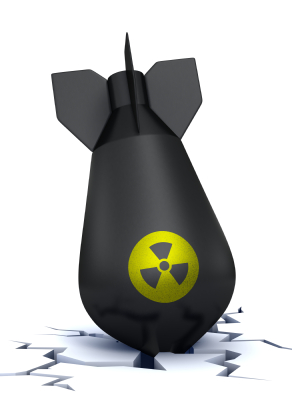Nuclear Wastrels
Pub Date: Oct 12, 2012
You would hope the folks overseeing our nuclear weapons arsenal would be conscientious, able to handle delicate instruments and fissile materials. Yet the way they handle our money makes us fear they shouldn’t be anywhere near a power switch, much less a ticking budget bomb or fiscal cliff.
We’re talking about the National Nuclear Security Administration (NNSA), the Department of Energy agency charged with the care and feeding of our nuclear arsenal. Anyone with a passing knowledge of NNSA knows it's screwed up, but recent events have pushed the situation from bad to worse. Let’s revisit just the latest disasters:
- Last week, NNSA officials admitted the Uranium Processing Facility at Tennessee’s Y-12 nuclear plant—the projected costs of which have ballooned from $600 million to $6.5 billion—must be redesigned because the building as planned won’t accommodate the facility’s required equipment. This is just the latest disaster in a trend of NNSA launching construction projects before designs are finalized.
- On September 26 of this year, the DOE Inspector General reported that efforts to refurbish the W-76 warhead will take longer and cost $221 million more than originally projected. Furthermore, cost increases are expected to continue due to production delays.
- That same week, contractors estimated the Mixed Oxide Fuel Program at NNSA’s Savannah River site in South Carolina would also need another $2 billion. The original cost of the facility, which is almost a decade behind schedule, has tripled to nearly $5 billion. Let’s also keep in mind that this is a program to produce a product that currently no one wants to buy.
- Earlier this summer, the Pentagon revealed that the cost of another refurbishing effort for the B-61 warhead had nearly doubled from $6 billion to $10 billion, causing Senate Energy and Water Chairwoman Dianne Feinstein (D-CA) to say, “we have to find a way to stop [cost overruns] from happening.”
- In February this year, NNSA put the $5 billion Chemistry and Metallurgy Research Replacement Nuclear Facility—a huge building at Los Alamos National Laboratory in New Mexico that would refurbish plutonium pits for warheads—on ice indefinitely after cost and schedule overruns.
And we won’t even go into NNSA’s failure this year to turn in budget plans, the break-in by activists into the Y-12 complex this summer, or the $5 billion laser at California’s Lawrence Livermore Laboratory—the most expensive federal science project ever—that missed its October deadline to prove it can work.
NNSA has been on the Government Accountability Office’s High Risk list for years, yet change is never anywhere in sight. Why? Is NNSA set up to fail because of its location in DOE, which has a different mission? Is it hamstrung by excessive oversight, as lab officials claim, or skating by with too little? Is the science so complicated that policymakers’ eyes glaze over instead of conducting oversight? Or could it be that the contractors who actually run the place are getting off too easy?
DOE is the largest federal contracting client outside of the Defense Department: Nearly 90 percent of its $26 billion annual budget goes to contractors. NNSA accounts for nearly 40 percent of DOE’s budget, and the laboratories and production plants that comprise the national nuclear weapons “complex” are actually operated and managed by private corporations. The arrangements these corporations work under, known as “Government-Owned, Contractor Operated” contracts or “GOCOs,” have done nothing to lessen NNSA’s persistent problems of inflated overhead costs, security breaches, and construction cost overruns, and in some cases actually increased them.
Lawmakers and the administration have to reexamine these arrangements as they look for savings. The Cold War ended twenty years ago, so we’re past due to rein in the $11 billion we spend each year on nuclear weapons. The nation is slated to spend $640 billion on the nuclear complex over the next decade, according to some estimates. With a $16 trillion debt and annual budget deficits exceeding a trillion dollars, it’s time to take some bombs off of NNSA’s hands.
TCS Quote of the Week:
“I think that’s difficult to do … You know, and frankly, I’m not sure it’s the right thing to do — have a lot of retiring members and defeated members voting on really big bills. Eh, probably not the appropriate way to handle the lame duck.”
– Representative John Boehner (R-OH), Speaker of the House, on the potential for a deficit deal before the end of the year. (Politico)










